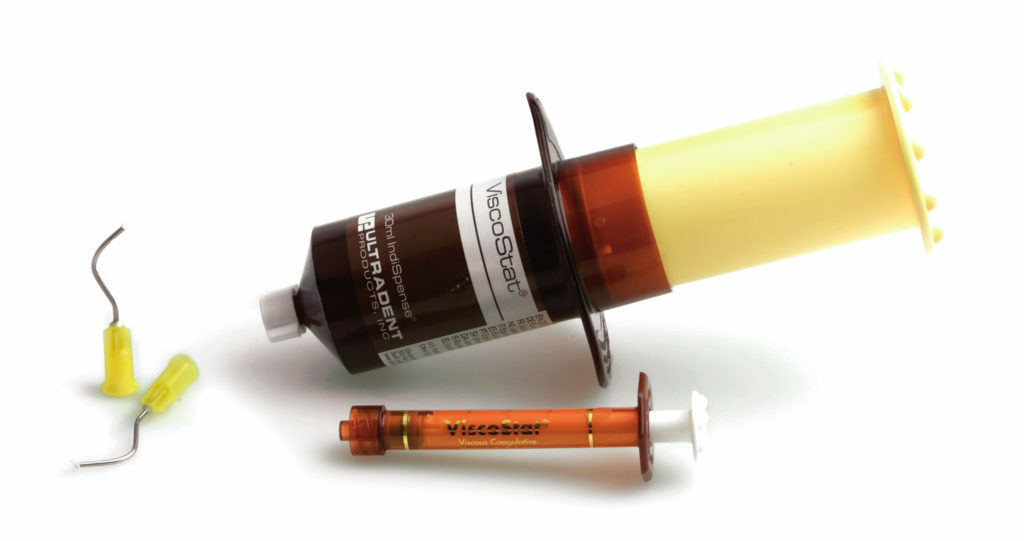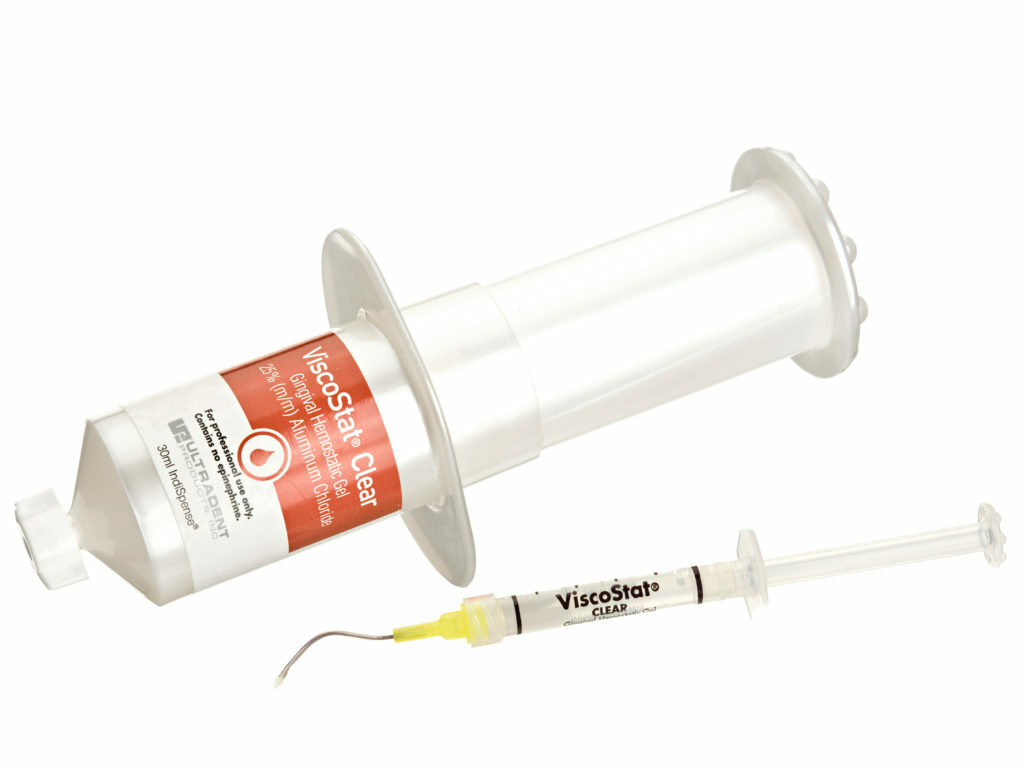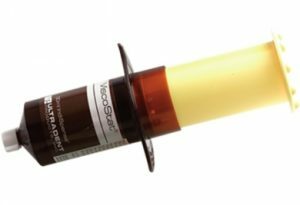 Bleeding is the companion of many diseases. Throughout its history, mankind has constantly struggled with this formidable symptom.
Bleeding is the companion of many diseases. Throughout its history, mankind has constantly struggled with this formidable symptom.
Methods that stop bleeding can be conditionally divided into surgical and medicinal. In particular, in dentistry, chemical methods of stopping are used, since in this area one has to deal with capillary bleeding.
Viscostat is a dental consumable for stopping bleeding during gingival retraction. Manufacturer - the company Ultradent( USA), a recognized leader in the manufacture of dental materials and tools.
Viscostat is available in two forms:
- ViscoStat with 20% ferrous sulphate;
- ViscoStat Clear with 25% aluminum chloride.
The sale comes in 30 ml IndiSpense syringes complete with 1,2 ml syringes, equipped with Metal Dento-Infusor metal tips, and Ultrapak retraction.
content
- Description preparation
- Dosing
- Applications preparation
- gingival retraction
- Mechanical
- Chemical
- Surgical
- ViscoStat for beautiful smile
- Direct restoration
- Indirect restoration
- Safety
- cost Viskostat
Description
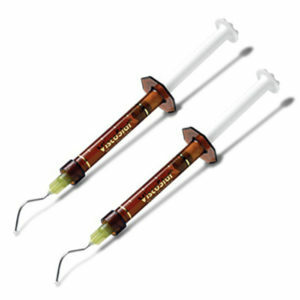
ViscoStat preparation with iron sulfate - liquid substance orangecolors. It is intended solely for haemostatic effect. It colors the gums, which allows the dentist to track the area of application of the drug. It is not suitable for front incisors due to its coloring properties.
ViscoStat with aluminum chloride is a clear gel of viscous consistency. It is used not only to stop bleeding, but also for chemical graft retraction.
Due to its transparency it is clearly visible, which is convenient for hemostasis fixation. The same quality causes the use of ViscoStat Clear for aesthetic restoration of teeth.
How to use
For proper use of Viscostat, follow the step-by-step instructions for use from the manufacturer of this supply: Ultradent:
- Step 1 .Remove the cap from the IndiSpense syringe containing the consumables you need.
- Step 2 .On its external thread, screw a 1.2 ml syringe. Check the accuracy of the connection to avoid leakage of the consumable. Step 3 .Smoothly press the plunger of the IndiSpens syringe and fill the working syringe.
- Step 4 .Disconnect the syringes. IndiSpense syringe close.
- Step 5 .Attach the Metal Dento-Infusor nozzle to the working syringe.
Before using the drug in the patient's mouth, check whether it is squeezed out well from the syringe. With each new application, use new syringes and attachments to prevent cross contamination. The composition lasts from 1 to 3 minutes.
Areas of application of the preparation
Viscostat as an expendable material is widely used in dentistry. This is the therapeutic treatment, and restoration activities, and the removal of casts. The main application of the gel is gum retraction. Skilful, accurate expansion of the gingival groove is a very important procedure.
Before using it, you must collect a patient's medical history. This will give an opportunity to decide which drug can be used in each case, pick up a thread with impregnation or not. It is known that epinephrine HCL can cause an increase in blood pressure. For such patients the use of Viscostat with aluminum chloride is shown. Often you have to use a non-threaded thread.
Gum retraction
At dental sites Viscostat is positioned primarily as an expendable material for gingival retraction. This procedure is a process of stretching the gingival margin and exposing the root part. Manipulation is necessary, but not always easily tolerated by patients and causes local capillary bleeding.
In what cases is it impossible to do without this painful procedure? Dentists resort to it in the treatment of caries, which are located high on the body of the tooth. The risk of touching the soft tissues of the mouth causes the doctor to push the gingival groove.
The desire to protect the gums from injury promotes the use of retraction in bleaching and mechanical removal of dental deposits. In addition, access to the plaque, which is located deep under the gum edge, is opened, which makes it possible to achieve the required quality of the procedure.
Initially, the retraction was used in orthopedics: impression making, fit to the size of crowns and veneers.
Types of retraction: 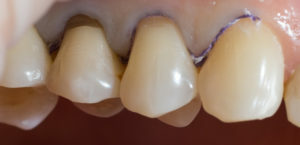
- mechanical;
- chemical;
- surgical.
Mechanical
Before starting the procedure, an anesthetic is injected into the gum to reduce pain. The dentist selects a string of the required thickness, in accordance with the structure of the oral cavity of the patient. The thread is tightly covered with a loop on the tooth's body and is placed in the gingival groove with a special tool.
Practitioners prefer threads that are impregnated with solutions that provide hemostatic and even analgesic effect. Such solutions include ViscoStat with 20% iron sulphate content. The components of this drug cause the formation of collagen, capping capillary vessels, thus stopping bleeding.
After removal of the thread, clots remain in the gingival groove, which must be washed out with a strong stream of water and dried with air to continue treatment. As mentioned above, preparations containing iron are not suitable for manipulating visible teeth, since they color the gums in a dark color.
Chemical
With this kind of lifting the gums are applied gels or pastes that act on the oral mucosa, narrowing it. A chemical substance, such as Viscostat Clear, is injected into the gingival groove and pressed with a plastic crown. Gel Viscostat is designed for such manipulations: it is thick, which means it does not spread over the tooth, it has a haemostatic property. Its transparency is an additional "bonus" for the doctor, as it allows you to track the process of hemostasis.
The gel is applied to the work surface using a syringe that comes with this consumable. Above, the method of using a syringe with a Metal Dento-Infusor nozzle has already been described. The composition is on the tooth's body for about 3 minutes, as a longer exposure is fraught with chemical burns.
After finishing the procedure, it is recommended to thoroughly wash the formed "pocket".Aluminum chloride, which is part of the gel, provides not only hemostatic, but also pronounced astringent effect.
Surgical
When the gingival tissue grows strongly, up to the size of the pathology, there is no other way to outline the basal area, except for surgical intervention. A scalpel or laser beam is used.
Dentists rarely stop at any one method of retraction. Various features of the physiology of the oral cavity of patients are encouraged to use various combinations of methods. Thus, mechanical retraction is often combined with chemical retraction. The use of ViscoStat Clear gel is accompanied by the use of a retraction thread.
ViscoStat for a beautiful smile
Not only the needs of treatment, but also the aesthetic demands of patients cause the wide application of retraction in dental practice. Often even healthy teeth need some kind of improvement of their kind. The role of a beautiful, visually attractive smile in interpersonal communication can not be overemphasized. From the aesthetic state of the teeth, the worldview and even the character of a person largely depends.
Restoration of teeth with modern filling materials is able to cope with various types of defects:
- severe caries lesion;

- chip or uneven shape;
- crevice between teeth;
- enamel defects.
In contrast to prosthetics, cosmetic restoration of teeth is a more gentle method. They resort to it to restore not only the form, but also the color. And the new teeth will not differ from the "native".At cost, this procedure is much cheaper and does not take much time. There are direct and indirect methods of restoration of teeth.
Direct restoration
This is the method of forming a new tooth directly in the mouth of the patient. At the same time, the newest light-curing composites and ionomer cements are used. In favor of this method, it can be said that the restoration of the teeth on the pins can take only one day.
And, if the patient's state of health allows, the doctor can restore up to six teeth at a time. The disadvantage of this method is the fragility of the appearance of the restored teeth: over time they begin to fade. Therefore, care for such teeth is of great importance, in particular, the choice of toothpaste.
Indirect restoration of
The method used for crowns and veneers is therefore called indirect, which implies the manufacture of veneers of fine porcelain or composites in laboratory conditions. The crown covers the whole tooth, veneer - only its frontal part.
The use of veneers is justified, if the tooth enamel is by nature not sufficiently white, and the methods of bleaching do not allow achieving the desired result. However, the installation of veneers has its limitations. It is not recommended to wear veneers to people with an incorrect bite or actively engaged in extreme sports( boxing, hockey), as well as patients with missing chewing teeth.
The restoration contains several stages:
- preparatory part, in which the tooth is cleaned and treated, if necessary;
- impression taking and making a veneer;
- veneer fitting;
- installation on the restored tooth.
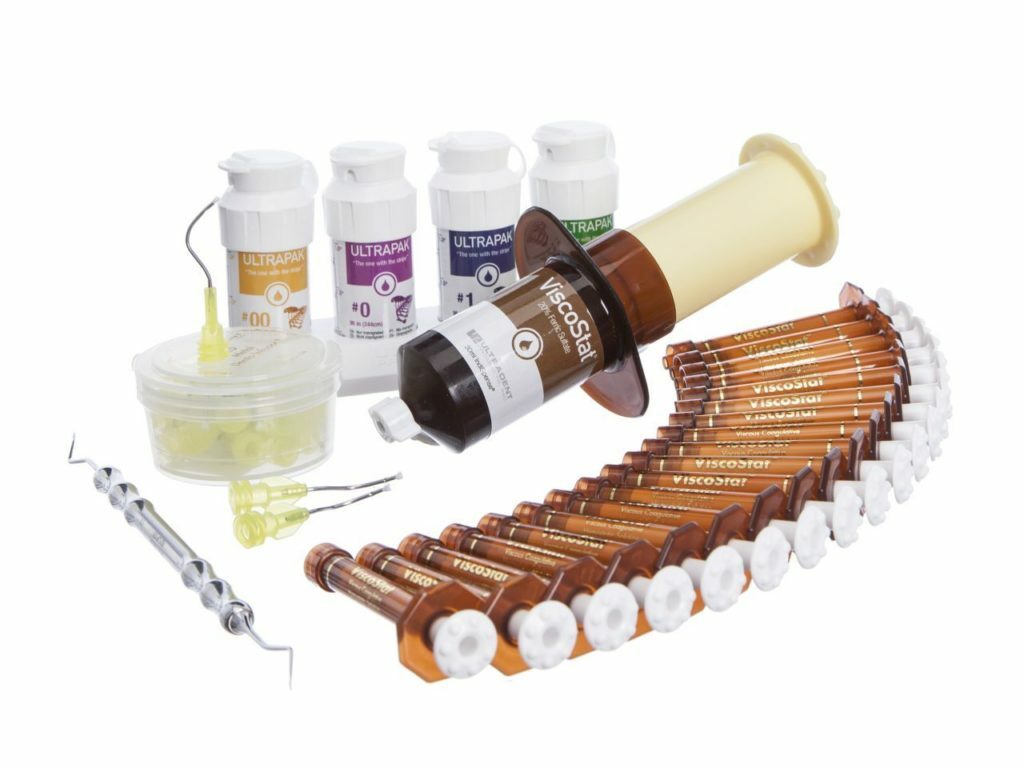
The "Person in Action" of this article - the consumable dental material Viscostat Clear comes out on the scene in the second part of the restoration process. To make the impression as precisely as possible, it is necessary to expose the tooth's body as much as possible. For this purpose, a gel is used in combination with a retraction thread.
After the gingival groove is drawn, the thread is removed, the working area is dried by a strong air flow to remove the gingival secretions and clots of the coagulum. On a dry surface, a silicone is applied, fixing the mold on which the impression will be made.
Safety precautions
Viscostat is intended for professional use, requires careful familiarization with the instructions from the manufacturer, which is necessary to achieve the maximum effect from the use of the drug.
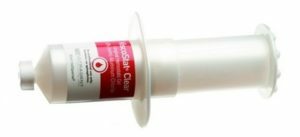 Viscostat solution and gel contain chemicals that can cause an allergic reaction in a number of patients. Use with caution.
Viscostat solution and gel contain chemicals that can cause an allergic reaction in a number of patients. Use with caution.
The composition of consumables is able to react with composites, which requires thorough washing with water and drying with a stream of air.
Viscostat is used in the oral cavity where there are many pathogenic microorganisms. Follow the change of the nozzle with each new use of the syringe, promptly and necessarily dispose of the used syringes and nozzles.
Always check that the gel is squeezed out of the syringe before starting work. At the slightest difficulty, replace the tip.
Do not allow product to enter the patient's digestive tract. When working with Vicostat, protect your eyes with a shield, wear protective clothing.
Cost Viscostat
The World Wide Web provides many opportunities to purchase Viscostat, a highly effective tool for dental practice. Depending on the fluctuation of the exchange rate of the price of the drug may vary.
On average, it varies from 2 to 3 thousand for an IndiSpense syringe with a volume of 30 ml. In addition, you will need to buy a 1.2 ml syringe, Ultrapak thread, Metal Dento-Infusor. Since this toolkit will be needed more than once, it will not have to be purchased in a boxed version, although it is offered in the dental equipment market in this way.
In this regard, it is much more advantageous to purchase Viscostat kit, which includes 20 syringes with a volume of 1.2 ml with Metal Dento-Infusor nozzles and a non-impregnated Ultrapak filament of four sizes. The cost of the kit is only two times higher than the price of the hemostatic agent sold in a single variant.
Strictly follow the manufacturer's instructions for Viscostat. This will allow using the drug as comfortable as possible for the patient and achieve the desired effect

